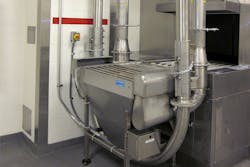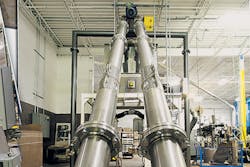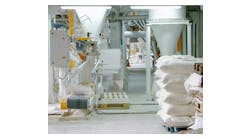Advantages of tubular drag conveyors for bulk solids transfer
Pneumatic conveying is often considered the standard method of transferring materials in bulk solids plants. In many applications, however, another type of mechanical conveying — tubular drag conveying — can be a more cost-effective option. Because bolstering the bottom line is a top priority for most material handling operations, tubular drag conveyors are certainly worthy of consideration when specifying new or replacement equipment.
There are several similarities between the two solutions. Like a pneumatic conveying system, a tubular drag conveyor (also called a tubular drag chain conveyor) provides enclosed conveying and can be custom-designed to handle short or long conveying distances, multiple material feed and discharge points, and a range of material and process requirements.
The tubular drag conveyor, however, offers a significant advantage over its pneumatic counterpart: It uses considerably less energy.
A tubular drag conveyor’s lower electrical power consumption means it has much lower operating costs — and as a result, a much lower long-term ownership cost — than a pneumatic conveying system. There are other advantages, but first, this article examines the equipment’s components and operation to provide a better understanding of why tubular drag conveyors are a desirable alternative to
pneumatic conveying.
How a tubular drag conveyor works
A tubular drag conveyor gets its name from the tubular housing that encloses a continuous chain. A drive sprocket inside a drive assembly engages the chain at the turn located at the conveying leg’s end, and circular discs called flights are attached to the chain at regular intervals. Flights constructed of ultra-high-molecular-weight polyethylene (UHMW-PE) are recommended for most applications because they are durable yet lightweight, they have a low cost, and unlike steel or iron flights, they provide quick release of sticky materials without wearing the conveyor bends and housing.
The conveyor’s tubular housing can be arranged in several configurations to suit a specific application. Housing sections are provided in lengths that facilitate creating a custom layout, and each section has bolted and gasketed flanged ends to maintain a tight seal while allowing easy field installation. The housing can be made of carbon steel or stainless steel and is available in diameters between 3 and 12 inches.
In terms of capacity, a tubular drag conveyor can move material at a maximum of 50 cubic feet per minute (ft3/min). The actual conveying capacity will depend on the housing diameter, the distance between flights and the chain speed, which will vary based on the material type in a given application.
Advantages of tubular drag conveyors
As mentioned earlier, a tubular drag conveyor uses less power and is much less costly to operate than a pneumatic conveying system. But why? A pneumatic system has several components that require a large amount of electrical power, most of it consumed by the motors that run the system’s fan or blower and rotary valves. If the system operates in dense phase, it has a pressure tank that requires large quantities of compressed air — another major energy draw. The compressed air system that supplies filter-cleaning air to the system’s filter receiver consumes additional electrical power.
In contrast, a tubular drag conveyor typically has one small motor for its drive assembly. The motor’s variable-speed drive also mitigates spikes in energy use, reducing the equipment’s overall energy requirement. For example, the fan in a high-pressure-capacity pneumatic conveying system can require a 100-horsepower (hp) motor, while the tubular drag conveyor’s drive assembly would require only a 15-hp motor to provide the same capacity.
The conveyor’s tubular housing can be arranged in several configurations to suit a specific application. The housing can be made of carbon steel or stainless steel and is available in various diameters.
Besides consuming less power, a tubular drag conveyor offers several other advantages over a pneumatic conveying system:
Slow, gentle handling. Compared to a pneumatic conveying system, material moves more slowly in a tubular drag conveyor. It is also handled gently in the spaces between the flights. This low-speed, low-pressure movement keeps blended materials from segregating and prevents degradation of fragile or friable materials.
Tolerance for tough materials. Because the material is carried between the flights, it is much easier to convey sluggish, sticky and easily compacted materials in a tubular drag conveyor than in a pneumatic conveying system, where such materials can form plugs.
No need for filters. Because very little air (or other gas) moves through a tubular drag conveyor, filtration is not necessary in this equipment. A pneumatic conveying system requires a filter receiver and several other filters at various points in the system, which translates to frequent maintenance and replacement.
Lower inert gas requirement. The minimal amount of gas moving through a tubular drag conveyor provides another advantage: In an application that requires blanketing a flammable or explosive material with an inert gas such as nitrogen, a tubular drag conveyor uses a fraction of the inert gas consumed by a comparably sized pneumatic conveying system.
Less noise. A tubular drag conveyor’s small motor and slow conveying speed make it much quieter than a pneumatic conveying system, which generates a lot of noise from its large fan or blower motor as well as other motors throughout the system. Even more noise is created by the intermittent blasts of compressed air for the filter receiver’s cleaning system and compressor operation for filling the pressure tank in a dense-phase system.
Less maintenance. In a pneumatic conveying
system, the fan or blower, rotary valves and filter receiver (and its filter-cleaning system) all require regular maintenance. A tubular drag conveyor requires comparatively little maintenance because it has far fewer components. Maintenance technicians will occasionally need to replace the flights at intervals that depend on the application, and also minimize slack in the chain, ideally about once a month. The slow conveying speed also extends the tubular drag conveyor’s life. Overall, less maintenance means a tubular drag conveyor can operate more reliably with less downtime and lower labor costs than a pneumatic system.
Modular construction. Most tubular drag conveyors have interchangeable components that allow the conveyor to be easily expanded or reconfigured to change the length, conveying path and the number of inlets and outlets. These modifications are more complex and time-consuming with a pneumatic conveying system because it has more components and electrical connections.
Selecting a tubular drag conveyor
Partnering with a reputable material handling equipment supplier is the key to choosing the best tubular drag conveyor to handle an application’s unique material and process requirements. Ideally, the supplier will have many years of experience in designing tubular drag conveyors and handling a wide range of tough materials and operating conditions. The customer will still need to provide information about the characteristics of the material being handled, especially particle size, bulk density and flow properties.
The supplier will also need to know application details such as available floor space and headroom in the plant, how material will be stored prior to conveying, the distance the material will be conveyed and the available energy source. An important part of the equipment selection process is testing the customer’s material in a tubular drag conveyor in the supplier’s lab. Based on the test results, the supplier can help determine which conveyor components and options are ideal for the application.
Joe Zerbel is a senior project manager for Hapman and has more than 25 years of mechanical conveying design and application experience. Zerbel may be reached at [email protected]. Hapman is a global leader in the design and manufacture of equipment and systems for bulk material handling.



